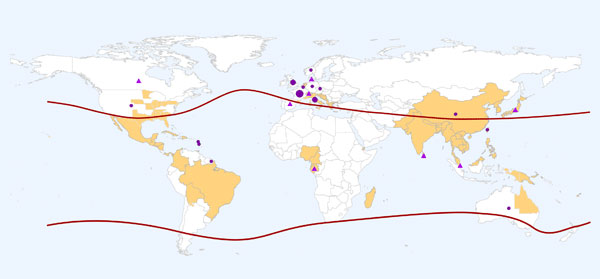Volume 16, Number 1—January 2010
Letter
Imported Chikungunya Virus Infection
Appendix Figure

Appendix Figure. Imported cases of chikungunya virus infection and known and theoretical geographic distributions of Aedes albopictus and Ae. aegypti mosquitoes. World repartition of Ae. albopictus mosquitoes (tan areas) and theoretical dispersion of Ae. aegypti in 2008 (the band between red lines, which represent the 10°C isotherms) according to the World Health Organization. Areas where imported cases of chikungunya have been reported during 2005–2008 are marked with a purple circle (small: 1–73 cases; medium: 74–300 cases; large: >300 cases) or a purple triangle when the number of imported cases was unknown. Data sources: US Centers for Disease Control and Prevention, World Health Organization, and literature review on Medline by Pubmed (4–8). Map drawn using ARCGIS version 9.2 (www.esri.com/software/arcgis).
References
- Powers AM, Logue CH. Changing patterns of chikungunya virus: re-emergence of a zoonotic arbovirus. J Gen Virol. 2007;88:2363–77. DOIPubMedGoogle Scholar
- Pialoux G, Gauzere BA, Jaureguiberry S, Strobel M. Chikungunya, an epidemic arbovirosis. Lancet Infect Dis. 2007;7:319–27. DOIPubMedGoogle Scholar
- Josseran L, Paquet C, Zehgnoun A, Caillere N, Le Tertre A, Solet JL, Chikungunya disease outbreak, Reunion Island. Emerg Infect Dis. 2006;12:1994–5.PubMedGoogle Scholar
- Gratz NG. Critical review of the vector status of Aedes albopictus. Med Vet Entomol. 2004;18:215–27. DOIPubMedGoogle Scholar
- Paupy C, Delatte H, Bagny L, Corbel V, Fontenille D. Aedes albopictus, an arbovirus vector: from the darkness to the light. Microbes Infect. 2009;11:1117–85. DOIGoogle Scholar
- Scholte E, Schaffner F. Waiting for the tiger: establishment and spread of the Aedes albopictus mosquito in Europe. In: Takken W, Knols B, editors. Emerging pests and vector-borne diseases in Europe, ECVD. Wageningen (the Netherlands): Wageningen Academic Publishers; 2007. p. 241–60.
- Russell RC, Williams CR, Sutherst RW, Ritchie SA. Aedes (Stegomyia) albopictus—a dengue threat for southern Australia? Commun Dis Intell. 2005;29:296–8.PubMedGoogle Scholar
- Fontenille D, Failloux A, Romi R. Should we expect chikungunya and dengue in Southern Europe? In: Takken W, Knols B, editors. Emerging pests and vector-borne diseases in Europe, ECVD. Wageningen (the Netherlands): Wageningen Academic Publishers; 2007. p. 169–84.
- Rezza G, Nicoletti L, Angelini R, Romi R, Finarelli AC, Panning M, Infection with chikungunya virus in Italy: an outbreak in a temperate region. Lancet. 2007;370:1840–6. DOIPubMedGoogle Scholar
- Centers for Disease Control and Prevention. Local transmission of Plasmodium vivax malaria—Palm Beach County, Florida, 2003. MMWR Morb Mortal Wkly Rep. 2003;52:908–11.PubMedGoogle Scholar